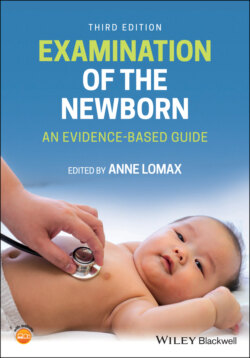Читать книгу Examination of the Newborn - Группа авторов - Страница 18
Third edition Examination of the Newborn: An Evidence‐Based Guide – what’s new?
ОглавлениеAll chapters in this edition have been updated with the most current PHE NIPE standards and programme handbook available at the time of writing. All website links have also been reviewed for currency. There is a website that accompanies this book that provides additional information on most aspects of examination of the newborn. This has also been updated.
The quick‐reference ‘Step‐by‐Step Guide to Examination of the Newborn’ has been brought forward from the accompanying webpage and can now be found in Appendix 1 of this book. The guide has been reviewed and updated and includes additional learning resources.
Chapter 1 deals with obtaining an accurate antenatal history and helps the practitioner gather all the necessary information prior to conducting the newborn examination. Claire Evans has reviewed and updated this chapter to provide the most current evidence available around this subject. Chapter 1 emphasises the importance of recognizing diagnostic information from the antenatal history and directs the practitioner to the optimal course of management. Claire has aligned some aspects of history taking with fetal development and factors that affect this, such as smoking, alcohol consumption, drugs, etc. There is also reference to maternal mental health and well‐being.
Chapter 2 applies the physiology of the fetal and neonatal cardiovascular and respiratory systems to the clinical examination. Chris Bedford has updated the information on pulse oximetry in line with current PHE NIPE guidelines. He also provides information on the latest information from Cochrane Reviews on the routine use of pulse oximetry in the examination of the newborn. The ‘Step‐by‐Step Guide to Examination of the Newborn’ (Appendix 1) and the website that accompanies this book contain links to videos and other sources of information to help you examine the heart and lungs effectively.
Chapter 3 deals with the neonatal skin and jaundice in the newborn and has been updated with more current references. The section on gestational age assessment and neonatal reflexes has been relocated and now forms a separate and discrete section in Chapter 5.
Chapter 4 looks at examination of the eyes, head and neck and includes an updated and extended section on examination of the mouth for cleft lip and palate with reference to the Royal College of Paediatrics and Child Health (RCPCH) best practice guide. Chapter 4 also includes some updated information on tongue‐tie and its treatment. More information on both of these topics can also be found on the website that accompanies this book.
Chapter 5 now provides information on assessment of gestational age and eliciting newborn reflexes, as it was considered that these two elements of the examination were more naturally aligned. There is also information and links to the updated World Health Organization (WHO) growth charts 0–4 years.
Chapter 6 details the examination of the abdomen and genitalia and has been updated with more current references.
Chapters 7 outlines the examination of the hips and lower limbs. This chapter has also been updated to reflect the current PHE 2018 standards and 2020 NIPE Programme Handbook.
Chapter 8 provides updated websites containing lots of additional evidence‐based information on chromosomal abnormalities. The practitioner must be suitably equipped to inform the parents in an effective and knowledgeable way that their baby has a congenital abnormality, and so the chapter provides the practitioner with information and support on giving feedback to parents.
Chapter 9 explores the behavioural aspects of the newborn in relation to the examination. It also reviews attachment theory and how practitioners can help parents form a bond with their baby in the early neonatal period. The chapter has been revised and updated by a new contributor, Clare Hughes, a midwifery lecturer from Queens University Belfast. She has included some current information on attachment theory and the importance of observing maternal and infant attachment during the examination of the newborn. This is a valuable addition to the chapter.
Chapter 10 has also been revised and updated and contains the latest information on the new Nursing and Midwifery Council (NMC) Standards for Pre‐Registration Midwifery Education (NMC 2019). There is also information on the examination of the newborn training and its inclusion into undergraduate midwifery programmes in England.
Appendix 1 now contains the quick‐reference ‘Step‐by‐Step Guide to Examination of the Newborn’. The guide has been reviewed and updated and includes additional learning resources.
